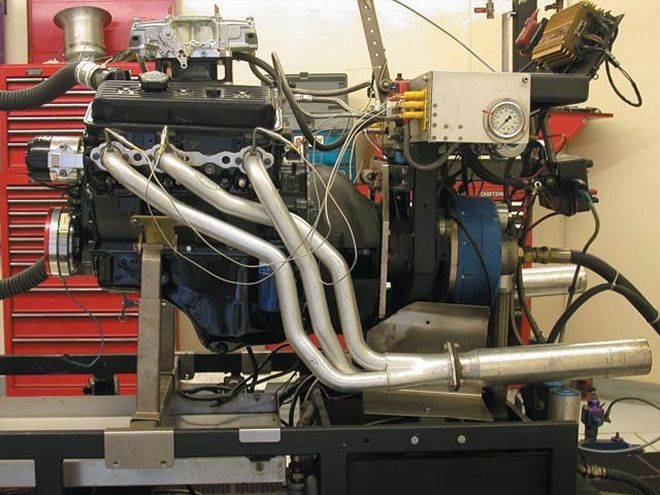
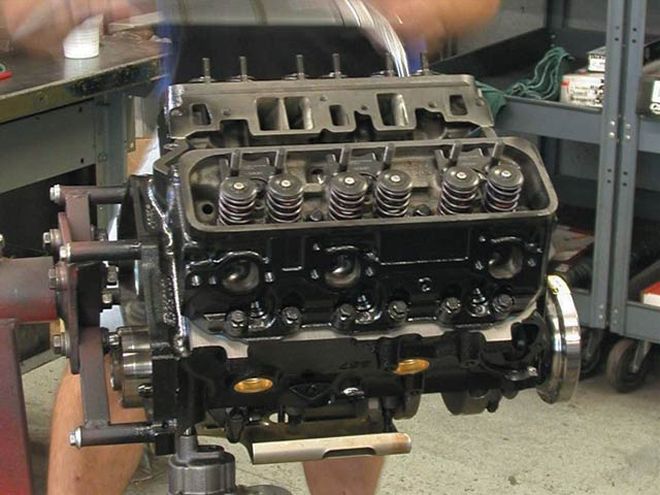
We were more excited to buzz this turkey on the dyno than we usually are with some whumpin' big-block. Why? It's different. Not too many people build V-6s any more. Perhaps we found out why, but we still think it's neat-or at least cute. See, the '85-up Chevy 4.3L, 262ci V-6 is very much like a small-block Chevy minus the number 3 and 6 cylinders (check the valve layout and you'll see how we came up with that conclusion). They're common in '88-up trucks, and we still get so many letters asking how to feed a V-8 to an S-10 truck that this time we elected to answer the question no one asked: How do you get more wheeze out of the stock 4.3?
But first, a little V-6 lore. The units we're concerned with are the Chevy 90-degree variety, meaning that the cylinder banks are set at a 90-degree angleto each other, just like a small-block V-8. The bore centers (4.400) and deck height (9.025) are also identical to a Mouse motor. The '85-up 4.3L V-6 has the same bore and stroke as a 350 V-8 (4.000x3.480), and takes the same pistons, cam bearings, main bearings, valvetrain parts, timing cover, oil pump, and front dress. Any V-8 trans will bolt right up to the 90-degree sixer. The 4.3L has much more performance potential than the '78-'79 200ci V-6 or the '80-'84 229ci version due to those engines' small 3.500- and 3.736-inch bores (they're like mini 262ci and 305ci V-8s). Also, the 200 and 229 have semi-odd-fire cranks (132/108-degree firing), while the 4.3Ls are true even-fire engines. Not that 4.3s aren't still quivering little suckers, hence the introduction of a balance shaft in the lifter valley of 4.3s beginning in late '92 or early '93. The even-fire 4.3 cranks can be identified by their split-pin cranks-each rod pin is offset in the middle by 30 degrees. There are also common-pin V-6 cranks (they look just like conventional V-8 cranks) developed for the Chevy V-6's Busch Grand National racing days, but those are odd-fire units.
Like the Chevy V-8, the 90-degree V-6 saw some transition during production: factory hydraulic roller lifters, one-piece rear-main seals, and center-bolt valve covers all appeared in '86-'87. Just like a V-8, one-piece-seal cranks can be swapped into two-piece-seal blocks with commonly available adapters. The 4.3L has been offered with carburetors, throttle-body injection, and the current central-port Vortech injection that was introduced in '95 (we think) along with an intake-manifold flange that requires vertical bolts; as far as we know, a carbureted intake is not available for V-6 Vortech heads.
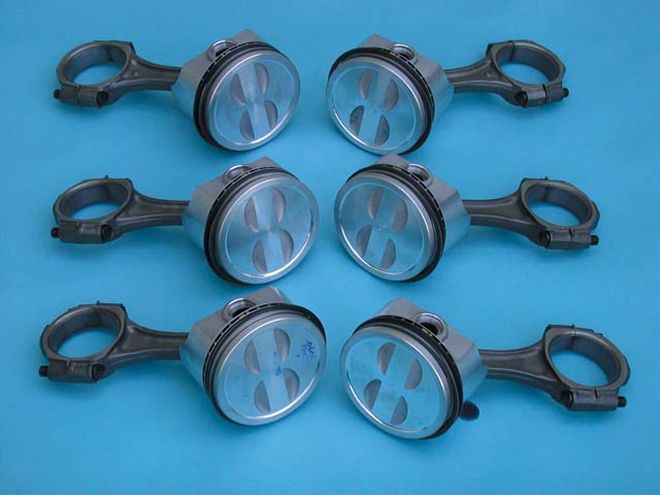
1 We began the 4.3L V-6 buildup with the knowledge that the pistons are the same as a 350 V-8's. Our pick was the Speed Pro LW2256-F-060, a lightweight forging (686 grams) with four valve reliefs with 6.1 cc of dish. The rings are Sealed Power R9902-060 file-fits set at 0.024 and 0.020, a bit wide so we can hammer this thing with nitrous and not worry about butting the end gaps. The V-6 is known as a shaker, so we had Dougan's Engine do a precision balance job.
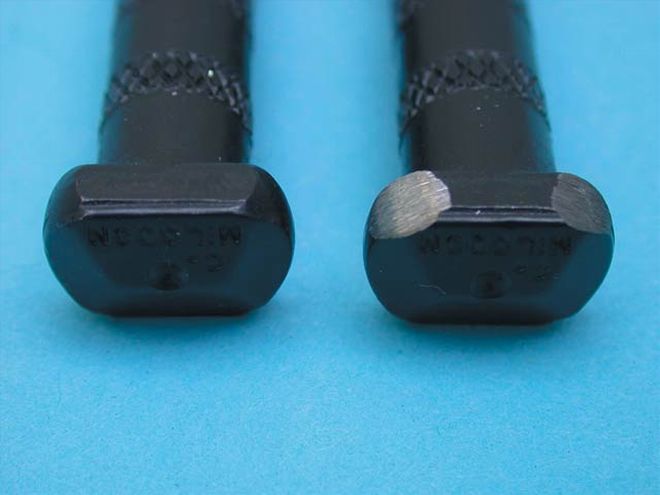
2 The 4.3L conrods are 5.700 inches like a 350, but the journal size is 2.250 rather than the V-8's 2.100; we presume that the reason for the bigger journal is to add strength to the offset-style rod pins on the crank. Dougan's was able to modify Milodon 190,000-psi rod bolts for a 350 application just by clearancing the heads a bit, as shown on the right.
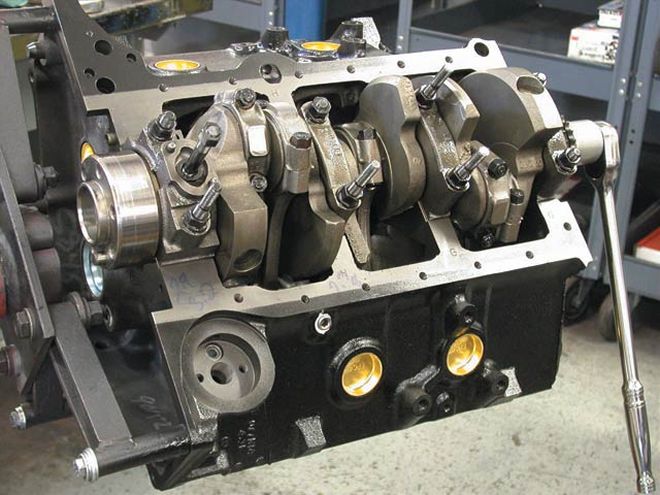
3 If our descriptions of a split-pin crank seemed a bit muddy, this photo should light a bulb for you. See how two rods (arrows) on the same journal are offset a bit? They're also separated by a cast-in thrust surface, and hence, the rods are narrower than a V-8's. Still, Sealed Power makes tri-metal bearings for the application (PN 6-1020CP). The Milodon main studs and oil-pump stud were sourced from a V-8 application. The oil-filter pad is much tinier than a V-8's; it takes an AC PF52 filter.
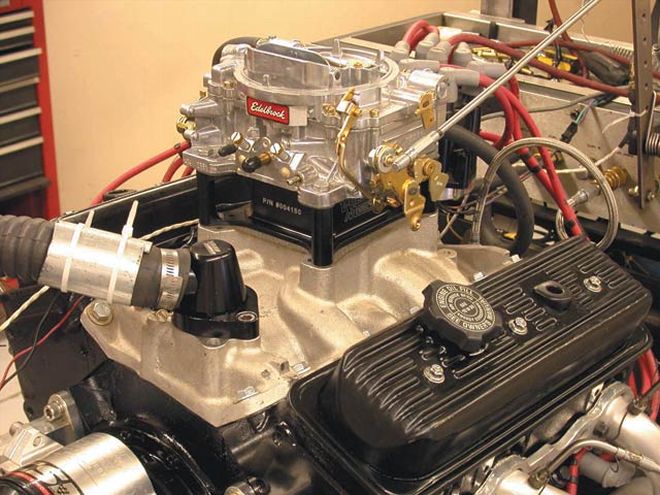
4 The Speed Pro pistons come stock with 6.1cc of valve relief. Combined with stock heads that Dougan's checked at 68cc chambers, pistons that we set at an average of 0.010 below deck, and Fel-Pro head gaskets with 0.041 compressed thickness, the V-6 would have 9.63:1 compression. Stock was 8.6:1. Because we changed plans midstream and decided to someday try the Vortech blower for carbs on this engine (see the story in this issue), we asked Dougan's to mill a 3.475x0.060 dish in the pistons for a total volume of 12 cc, lowering the compression to 9.08:1. For now, it runs fine on cheap gas.
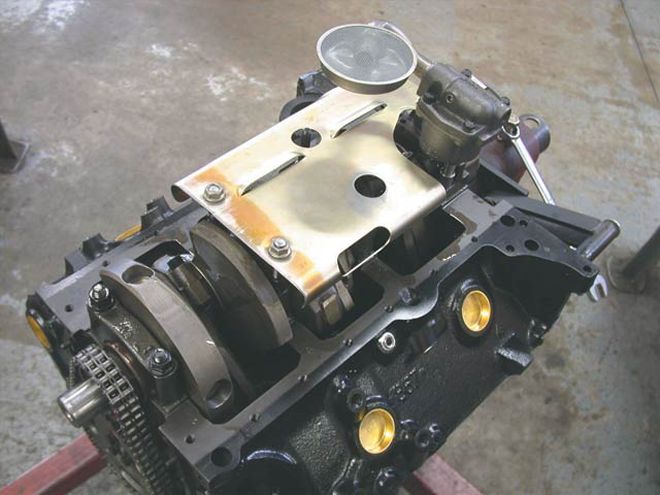
5 To wrap up the bottom end, we twisted Dougan's builder Jeff Jacobs' arm until he agreed to modify our Milodon 350 windage tray to fit the V-6. He cut a few inches off the front, enlarged one bolt hole (arrow) to clear the dipstick tube, and tweaked a few louvers to fit the stock oil pan. Also check out the oil pump and pickup-they are Sealed Power part numbers 224-43469V (pump) and 224-14263 (pickup), an upgrade over the stock V-6 parts because they employ a 3/4-inch pickup tube. The steel oil-pump driveshaft is Sealed Power PN 224-6146E.
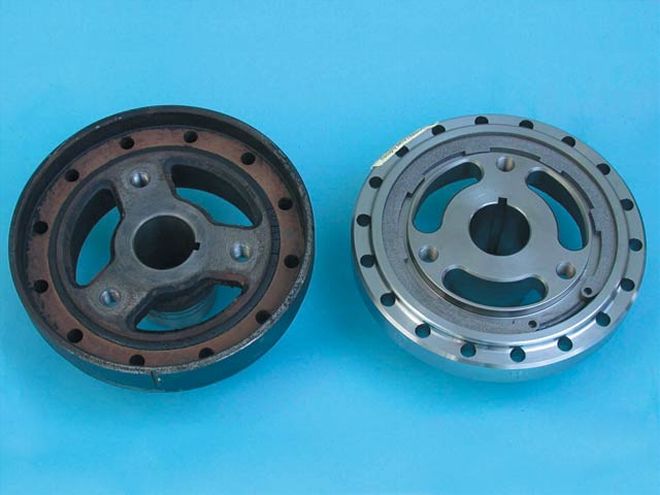
6 Dougan's Ray Field spotted the funky V-6 balancer (left) with a lip around the edge that might prevent the use of aftermarket pulleys even though the bolt pattern is the same as a V-8. You can use conventional short- or long-water-pump accessories on the 4.3. We also wanted a steel balancer in case we ever add the blower, and we needed an SFI-approved balancer for the track. Dougan's found that the Pioneer balancer (PN 872021) on the right is a 6.125-inch, lightweight V-8 unit that would fit perfectly. Neat! The 4.3L is an internally balanced engine like a 350.
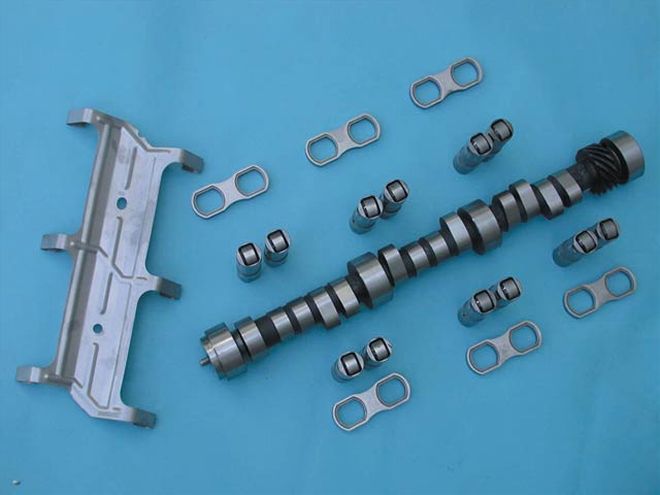
7 A 4.3L can be cammed just like it was a 350 because each cylinder has the same displacement as its V-8 bro, though cams will seem bigger in the V-6 because there's less power overlap. Off-the-shelf cam grinds are pretty tiny for use with the OE computer-controlled applications that house most of these engines. We nabbed Comp Cams biggest hydraulic roller for our factory roller block, a 280HR with 224/224 duration at 0.050, 0.525 lift, and a 110-degree lobe-separation angle. The cam kit (PN K09-430-8) comes with cam, lifters, retainers, locks, seals, timing set, valvesprings, pushrods, guideplates, and rocker studs. At $638.69 (Summit), it's the biggest expense of the buildup, but also the key to making this thing run.
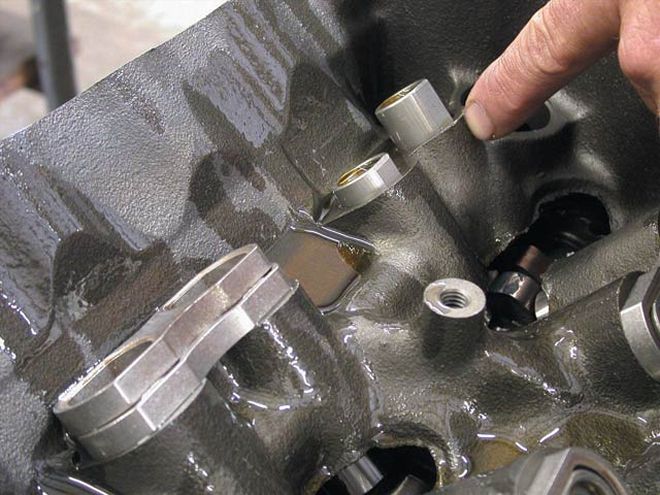
8 During assembly, Dougan's pointed out that the 0.350-inch lobe lift was all the block could take-any more and the hydraulic lifter would hit the stock-style link bars.
So our pick for a simple, budget, performance V-6 would be an '85-'92 unit without a balance shaft, and we have a slight preference for the earlier units with perimeter-bolt valve covers. They just look better, and based on our inspection of junkyard heads, we suspect that the early ones flow better. But avoid the 200 and 229 heads, which have 1.84-inch intake valves. Speaking of heads, you're sorta stuck with stockers. There was a time when GM Performance Parts had 23-degree, direct bolt-on performance heads and manifolds, but now only the hardcore 18-degree race heads and intakes are available; you can still get all kinds of iron and aluminum race blocks, too, including big-bore capability and priority-main oiling. We learned that Scat Crankshafts still has the very last few sets of Brodix 23-degree V-6 heads, but we were unable to find any others that are affordable. Similarly, intake manifold selection is pretty slim, and while most cam manufacturers can grind anything you want, the only off-the-shelf sticks are pretty mild. We decided to see what we could squeeze out of this thing with readily available parts and the production heads and block, skipping any rocket science. To duplicate every little nut and bolt we used would run about $3,000, including machine work.
The result was 301 hp at 5,500 rpm and 312 lb-ft at 4,700. Puny, but let us remind you that it's still 50 hp per cylinder (a similar 350 V-8 would make 400 hp), which is pretty good for the very mild parts we used. Besides, at 0.060-over, it's just 270ci. Naturally aspirated, our V-6 should put an S-10 into the 14s, and with forged pistons and studded mains, we're ready to nitrous this thing to at least 400 hp or add a Vortech blower for an easy 450 to run in the 12s or better. Even more interesting, Allstar Performance sells brackets to swap a 90-degree V-6 where a V-8 used to be, and the resulting engine setback could make this thing killer for handling applications in, say, a third-gen F-body.
Enough justification. We kind of like our little motor. Have a look at how we conspired with Dougan's Engine to make it run twice as hard as it did stock.
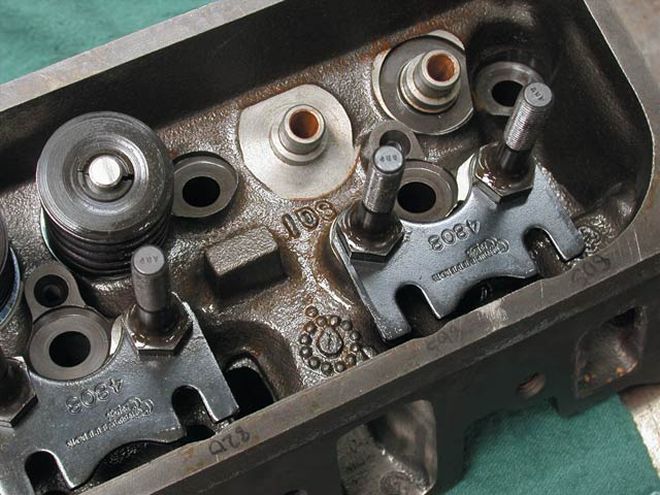
9 The valvesprings supplied by Comp were PN 986, though Dougan's stepped it up to a slightly stiffer 987 because we so often see valve float at 6,000 rpm with hydraulic rollers; as it turned out the power peak was at 5,500 anyway. However, either spring has a 1.430-inch diameter and the V-6 heads need to be machined to accept them, then the springs need stiff shims because there's not much meat in a few of the seats. Dougan's also modified the heads for 3/8-inch screw-in studs since we didn't trust the press-in style above 0.500-inch valve lift.
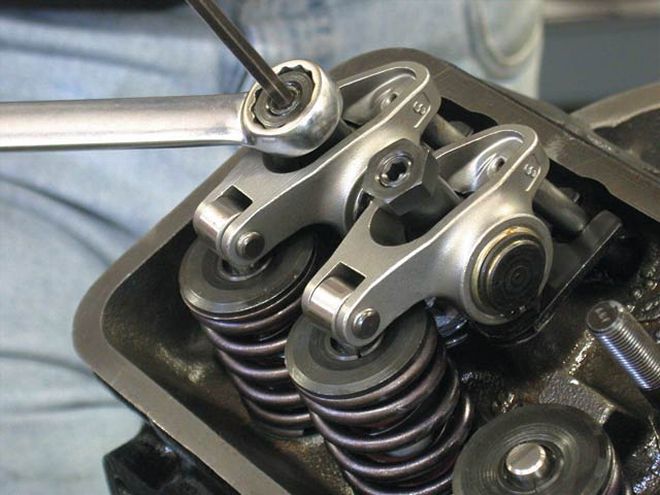
10 Speaking of lift, we amped the cam's 0.525 lift with 1.5:1 rockers up to 0.560 inch by substituting Comp Cams 1.6: Pro Magnum rockers (PN 1301-12). Next time we'd use the new self-guided rockers (PN 1318-12) and omit the guideplates, as the V-6 heads had some pushrod-angle problems with the V-8-type guideplates. We were surprised that the stock center-bolt valve covers cleared the rockers with no modifications.
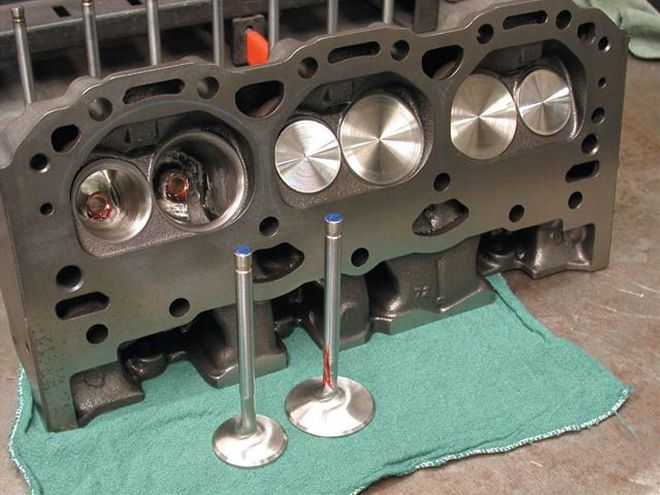
11 Because we found no practical aftermarket heads, and because simply cutting one cylinder off a V-8 head won't work, we had our pal Brulio at Westech Performance hog the stock heads for increased flow. These heads are terrible, and even after porting, they only flow about as well as stock 305 Chevy heads. Peak numbers were 208 cfm on the intake and 190 on the exhaust, which was a giant improvement over the pathetic 138/116-cfm baseline. Helping the cause were Milodon Megaflow swirl-polished, tulipped valves in 2.02/1.60 sizes (PNs 45015 and 45045), an upgrade over the stock 1.94/1.50s. Consider these steps mandatory to making any kind of decent power with your V-6.
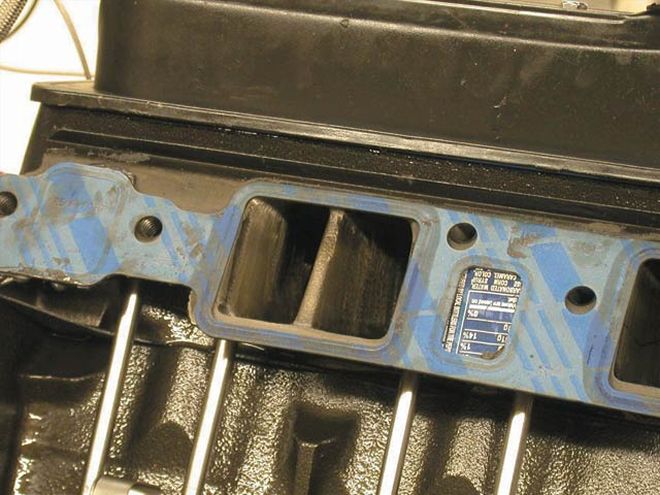
12 Fel-Pro gaskets were used throughout our little engine, and even though the intake set was clearly marked, we screwed up the first time and put them on backwards. Do so and you block the water passages to the head at the front of the block; they are shown here properly installed. Also note that we blocked off the heat crossover.

13 Header selection is very limited, and while Edelbrock makes tubular manifolds and systems for truck applications, they wouldn't fit the dyno. Instead we used a set of long-tube, coated S-10 headers from Hooker (PN 2842-1) They have tiny 15/8-inch primaries. 26-inch tubes, and small 21/2-inch collectors. We ran all our tests with collector extensions but no mufflers.
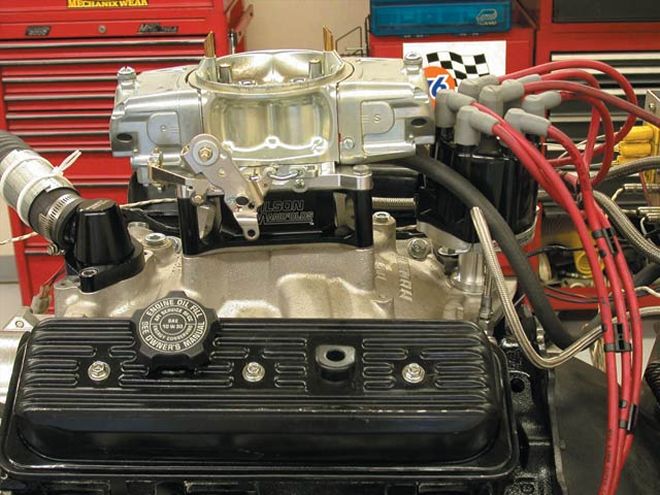
14 Ignitionwise, MSD still makes even-fire (PN 8597) and odd-fire (PN 8596) Pro Billet distributors for the 90-degree V-6. We used an even-fire unit with MSD 8.5mm Heli-Core wires and a Digital-7 ignition box. Note that the Demon or Holley-type carburetors will not fit this engine unless a 2-inch carb-spacer is used-otherwise the float bowls hit the distributor and water neck. If you don't want a cowl hood, stick with the Edelbrock carb.

15 Intake-manifold selection is very limited, and we chose an Edelbrock Performer (PN 2111). This is a very low-rise intake, and we made best power with a 2-inch spacer from Wilson Manifolds. The initial carb we used was an Edelbrock 500, which seemed to be jetted perfectly right out of the box. It turned in 288 hp at 5,400 and 303 lb-ft at 4,400. But strangely, the V-6 saw about 1.5 inches of manifold vacuum at WOT, indicating that the carb was a tad too small.
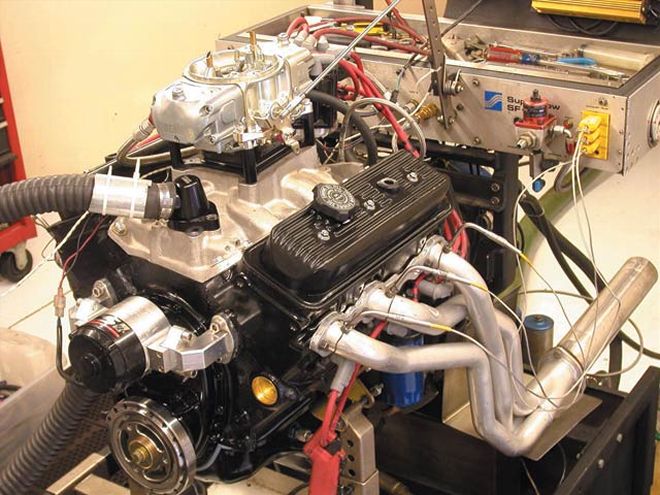
16 We didn't have a 600-cfm Edelbrock to try, so we added a 650-cfm Mighty Demon. It's nearly 300 bucks more than the Edelbrock 500, but kicked the power up to what we were looking for: 300 hp and 316 lb-ft.